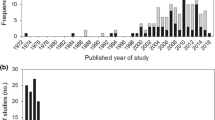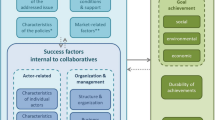Abstract
Effective invasive plant management requires collective action. However, little is known about what motivates individuals to work collectively. We conducted a mail survey of 2,600 randomly selected family forest owners in Indiana, USA to examine factors associated with community-led collective action. Specifically, we examined the role of perceived self-efficacy, perceived collective efficacy, concerns about invasive plants, and social norms associated with invasive plant management in shaping family forest owners’ self-reported likelihood to work with their neighbors to remove invasive plants. We found that past experience talking to others or working with neighbors to remove invasive plants were important predictors of landowners’ intention to work collectively, as were perceived self-efficacy in their own ability to manage invasive plants, perceived need for collective action, social norms, and concerns about invasive plants on neighboring or nearby properties. However, most socio-demographic characteristics (e.g., age, gender, education level, income) and land ownership characteristics (e.g., residence status, having a written forest management plan) were not statisically significant predictors of family forest owners’ likelihood to work with their neighbors. Our findings suggest that building individual sense of competence, facilitating neighbor interactions, and strengthening shared concerns may facilitate community-led collective action to manage invasive plants.
Similar content being viewed by others
References
Acock A (2016) A gentle introduction to stata. Stata Press, College Station, TX
Armstrong JS, Overton T (1977) Estimating nonresponse bias in mail surveys J Market Res 14(3):396–402
Bagavathiannan MV et al. (2019) Considering weed management as a social dilemma bridges individual and collective interests. Nat Plants 5:343–351
Bandura A (1997) Self-efficacy in changing societies, 1st edn. Cambridge University Press, Cambridge and New York, NY
Bandura A (2000) Exercise of human agency through collective efficacy. Curr Directions Psychol Sci 9(3):75–78
Burnham M, Ma Z (2017) Climate change adaptation: factors influencing Chinese smallholder farmers’ perceived self-efficacy and adaptation intent. Reg Environ Change 17:171–186. https://doi.org/10.1007/s10113-016-0975-6
Butler B et al. (2016) Family forest ownerships of the United States, 2013: findings from the USDA Forest Service’s National Woodland Owner Survey. J For 114(6):638–647
Canadas MJ, Novais A, Marques M (2016) Wildfires, forest management and landowners’ collective action: a comparative approach at the local level. Land Use Policy 56:179–188
Cialdini RB et al. (2006) Managing social norms for persuasive impact. Soc Influ 1(1):3–15. https://doi.org/10.1080/15534510500181459
Clarke M, Ma Z, Snyder S, Floress K (2019) What are family forest owners thinking and doing about invasive plants? Landsc Urban Plan 188:80–92
Collins CR, Neal JW, Neal ZP (2014) Transforming individual civic engagement into community collective efficacy: the role of bonding social capital. Am J Community Psychol 54(3–4):328–336
Cronbach LJ (1951) Coefficient alpha and the internal structure of tests. Psychometrika 16:297–334. https://doi.org/10.1007/BF02310555
Dillman DA, Smyth JD, Christian LM (2014) Internet, phone, mail and mixed-mode surveys: the tailored design method, 4th edn. John Wiley and Sons, Hoboken, NJ
Early R et al. (2016) Global threats from invasive alien species in the twenty-first century and national response capacities. Nat Commun 7:12485
Epanchin-Niell RS, Wilen JE (2015) Individual and cooperative management of invasive species in human-mediated landscapes. Am J Agric Econ 97:180–198
Epanchin-Niell RS et al. (2010) Controlling invasive species in complex social landscapes. Front Ecol Environ 8:210–216
Ervin et al. (2019) Farmer attitudes toward cooperative approaches to herbicide resistance management: a common pool ecosystem service challenge. Ecol Econ 157:237–245
Estévez RA et al. (2015) Clarifying values, risk perceptions, and attitudes to resolve or avoid social conflicts in invasive species management. Conserv Biol 29:19–30
Fischer P, Charnley S (2012) Private forest owners and invasive plants: risk perception and management. Invasive Plant Sci Manag 5(3):375–389
Fischer PA, Klooster A, Cirhigiri L (2019) Cross-boundary cooperation for landscape management: collective action and social exchange among individual private forest landowners. Landsc Urban Plan 188:151–162
Flint CG, Luloff AE (2007) Community activeness in response to forest disturbance in Alaska. Soc Nat Resour 20(5):431–450
Floress K et al. (2018) Factors associated with family forest owner actions: a vote-count meta-analysis. Landsc Urban Plan 188:19–29
Glen et al. (2017) Landholder participation in regional-scale control of invasive predators: an adaptable landscape model. Biol Invasions 19(1):329–338
Graham S (2013) Three cooperative pathways to solving a collective weed management problem. Australas J Environ Manag 20(2):116–130
Graham S (2019) Coordinating invasive plant management among conservation and rural stakeholders. Land Use Policy 81:247–255
Graham S, Rogers S (2017) How local landholder groups collectively manage weeds in South-Eastern Australia. Environ Manag 60(3):396–408. https://doi.org/10.1007/s00267-017-0859-7
Graham S et al. (2019) Opportunities for better use of collective action theory in research and governance for invasive species management. Conserv Biol 33:275–287
Head L (2017) The social dimensions of invasive plants. Nat Plants 3(6):17075
Hendee JD, Flint CG (2013) Managing private forestlands along the public-private interface of Southern Illinois: landowner forestry decisions in a multi-jurisdictional landscape. Policy Econ 34:47–55
Hershdorfer ME, Fernandez-Gimenez ME, Howery LD (2007) Key attributes influence the performance of local weed management programs in the Southwest United States. Rangel Ecol Manag 60:225–234
Jugert P et al. (2016) Collective efficacy increases pro-environmental intentions through increasing self-efficacy. J Environ Psychol 48:12–23
Jussaume et al. (2019) Producers, weeds, and society. J Integr Pest Manag 10(1):6
Kalnicky EA, Brunson MW, Beard KH (2019) Predictors of participation in invasive species control activities depend on prior experience with the species. Environ Manag 63(1):60–68
Kittredge DB (2005) The cooperation of private forest owners on scales larger than one individual property: International examples and potential application in the United States. For Policy Econ 7(4):671–689
Lubeck A et al. (2019) Collective factors drive individual invasive species control behaviors: evidence from private lands in Montana, USA. Ecol Soc 24(2):32
Ma Z, Clarke M, Church SP (2018) Insights into individual and cooperative invasive plant management on family forestlands. Land Use Policy 75:682–693
McKiernan S (2017) Managing invasive plants in a rural-amenity landscape: the role of social capital and Landcare. J Environ Plan Manag 61(8):1419–1437
Ma Z, Kittredge DB, Catanzaro P (2012) Challenging the traditional forestry extension model: Insights from the Woods Forum program in Massachusetts. Small-scale For 11(1):87–100
Marshall GR et al. (2016) Collective action in invasive species control, and prospects for community-based governance: the case of serrated tussock (Nassella trichotoma) in New South Wales, Australia. Land Use Policy 56:100–111
Niemiec RM et al. (2016) Motivating residents to combat invasive species on private lands: social norms and community reciprocity. Ecol Soc 21(2):1
Niemiec RM et al. (2017a) Civic and natural place attachment as correlates of resident invasive species control behavior in Hawaii. Biol Conserv 209:415–422
Niemiec RM et al. (2017b) Landowners’ perspectives on coordinated, landscape-level invasive species control: the role of social and ecological context. Environ Manag 59(3):477
Niemiec RM et al. (2018) Scale-dependence of environmental and socioeconomic drivers of albizia invasion in Hawaii. Landsc Urban Plan 169:70–80
Niemiec RM et al. (2019) Motivating landowners to recruit neighbors for private land conservation Conserv Biol 33:930–941. https://doi.org/10.1111/cobi.13294
Niemiec RM et al. (2020) Clarifying the degree and type of public good collective action problem posed by natural resource management challenges Ecol Soc 25(1):30
Nunnally JC (1978) Psychometric theory, 2nd edn. McGraw-Hill, New York, NY
Ostrom E (2010) Analyzing collective action. Agric Econ 41:155–166
Perrings C et al. (2002) Biological invasion risks and the public good: an economic perspective. Ecol Soc 6(1):1
Prinbeck G, Lach D, Chan S (2011) Exploring stakeholders’ attitudes and beliefs regarding behaviors that prevent the spread of invasive species. Environ Educ Res 17(3):341–352. https://doi.org/10.1080/13504622.2010.542451
Ravnborg HM, Westermann O (2002) Understanding interdependencies: stakeholder identification and negotiation for collective natural resource management. Agric Syst 73(1):41–56
Rickenbach M et al. (2011) Cross-boundary cooperation: a mechanism for sustaining ecosystem services from private lands. J Soil Water Conserv 66:91A–96A
Sagor ES, Becker DR (2014) Personal networks and private forestry in Minnesota. J Environ Manag 132:145–154
Schulte L, Rickenbach M, Merrick L (2008) Ecological and economic benefits of cross-boundary coordination among private forest landowners. Landsc Ecol 23(4):481–496
Simberloff D (2013) Invasive species what everyone should know. Oxford University Press, New York, NY, USA
Simmons E, Wilmot A (2004) Incentive payments on social surveys: a literature review. Soc Surv Methodol Bull 53:1–11
Snyder SA, Ma Z, Floress K, Clarke M (2020) Relationships between absenteeism, conservation group membership, and land management among family forest owners. Land Use Policy 19:104407
Stallman HR, James Jr HS (2015) Determinants of farmers’ willingness to cooperate to control pests. Ecol Econ 117:182–192
Sullivan A et al. (2017) De jure versus de facto institutions: trust, information, and collective efforts to manage the invasive mile-a-minute weed (Mikania micrantha). Int J Commons 11(1):171–199
Vaske JJ (2008) Survey research and analysis: applications in parks, recreation and human dimensions. Venture Publishing, State College, PA
Warne R (2018) Statistics for the social sciences: a general linear model approach. Cambridge University Press, New York, NY, USA
Yung L, Chandler J, Haverhals H (2015) Effective weed management, collective action and landownership change in Western Montana. Invasive Plant Sci Manag 8(2):193–202
Acknowledgements
The findings and conclusions in this publication are those of the authors and should not be construed to represent any official USDA or U.S. Government determination or policy. We thank Purdue University College of Agriculture AgSEED program, Purdue University Center for the Environment seed grant, USDA Forest Service Northern Research Station (FS Agreement No. 15-JV-11242309-037), and USDA Hatch fund (Accession No. 1007554) for their support. This work would have not been possible without all the private woodland owners in Indiana who participated in our survey. Finally, we thank Lenny Farlee and Liz Jackson for their help during the development and implementation of this research project.
Author information
Authors and Affiliations
Corresponding author
Ethics declarations
Conflict of Interest
The authors declare no competing interests.
Additional information
Publisher’s note Springer Nature remains neutral with regard to jurisdictional claims in published maps and institutional affiliations.
Supplementary Information
Rights and permissions
About this article
Cite this article
Clarke, M., Ma, Z., Snyder, S.A. et al. Factors Influencing Family Forest Owners’ Interest in Community-led Collective Invasive Plant Management. Environmental Management 67, 1088–1099 (2021). https://doi.org/10.1007/s00267-021-01454-1
Received:
Accepted:
Published:
Issue Date:
DOI: https://doi.org/10.1007/s00267-021-01454-1




